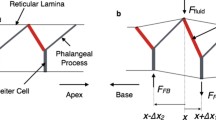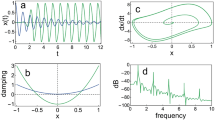Abstract
The interpretation of observations of basilar-membrane response to pure tones, and also the analysis of mathematical models of the mechanical response of the cochlea, are both valuably facilitated by a description in terms of energy flow. An attempt is made to describe this approach clearly, to demonstrate its advantages, and to relate it to other approaches.
Access this chapter
Tax calculation will be finalised at checkout
Purchases are for personal use only
Preview
Unable to display preview. Download preview PDF.
Similar content being viewed by others
References
De Boer, E. (1979) Short-wave world revisited: resonance in a two-dimensional cochlear model. Hearing Research 1, 253–281.
Holmes, M.H. (1982) Dynamics of the inner ear. Journal of Fluid Mechanics 116, 59–75.
Lighthill, J. (1978) Waves in Fluids (Cambridge University Press, Cambridge).
Lighthill, J. (1981) Energy flow in the cochlea. Journal of Fluid Mechanics 106, 149–213.
Steele, C.R. (1974) Behaviour of the basilar membrane with pure-tone excitation. Journal of Acoustical Society of America 55, 148–162.
Steele, C.R. and Taber, L.A. (1979) Comparison of ‘WKB’ and finite difference calculations for a two-dimensional cochlear model. Journal of Acoustical Society of America 65, 1001–1006.
Viergever, M.(1980) Mechanics of the Inner Ear (Delft University Press, Delft).
Voldrich, L. (1978) Mechanical properties of basilar membrane. Acta Otolaryngologica 86, 331–335.
Whitham, G.B. (1974) Linear and Nonlinear Waves (Wiley, New York).
Author information
Authors and Affiliations
Editor information
Editors and Affiliations
Rights and permissions
Copyright information
© 1983 Delft University Press, The Netherlands
About this paper
Cite this paper
Lighthill, J. (1983). Advantages from Describing Cochlear Mechanics in Terms of Energy Flow. In: de Boer, E., Viergever, M.A. (eds) Mechanics of Hearing. Springer, Dordrecht. https://doi.org/10.1007/978-94-009-6911-7_8
Download citation
DOI: https://doi.org/10.1007/978-94-009-6911-7_8
Publisher Name: Springer, Dordrecht
Print ISBN: 978-94-009-6913-1
Online ISBN: 978-94-009-6911-7
eBook Packages: Springer Book Archive




